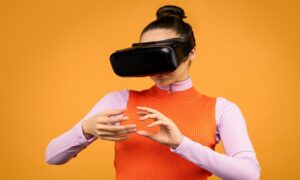Have you ever wished to step into a world where fantasy and reality seamlessly intertwine? Where dragons can roam the streets and you can paint masterpieces on thin air? Welcome to the magical realm of mixed reality, a cutting-edge technology that brings your wildest dreams to life. But how does this enchanting concept actually work? In this blog post, we’ll embark on an extraordinary journey as we demystify mixed reality and uncover the fascinating technology behind it.
What is Mixed Reality?
Mixed reality (MR) is a term for the melding of real and virtual worlds to produce new environments and visualizations where physical and digital objects co-exist and interact in real time.
A mixed reality experience can be delivered through a headset or on a device like a smartphone, and it often includes some combination of augmented reality (AR), virtual reality (VR), and 360-degree video or photography. With mixed reality, you can view digital content superimposed on the real world or immerse yourself in a completely virtual environment.
Some popular examples of mixed reality experiences include Microsoft HoloLens, Magic Leap One, and Google Tango.
How Does Mixed Reality Work?
Mixed reality is still a relatively new concept, and as such, there is not a ton of information out there about how it actually works. That being said, there are a few key things to know about mixed reality in order to understand how it works.
Mixed reality is essentially a mix of virtual reality and real life. It allows users to interact with both the real world and the virtual world at the same time. This can be done through a number of different mediums, including augmented reality, virtual reality, and even mixed reality headsets.
The way that mixed reality works is by using computer-generated images to augment your view of the real world. These images can be anything from 3D objects to entire environments. You can interact with these images just like you would with anything else in the real world. For example, you can pick up virtual objects or move around in virtual environments.
One of the key things that makes mixed reality so interesting is that it has the potential to blur the lines between what is real and what is not. This technology has the ability to completely change the way we interact with both the real and virtual worlds.
Advantages of Mixed Reality
Mixed reality is still a relatively new technology, but it has already shown a lot of promise. Here are some of the advantages of mixed reality:
1. Increased immersion and engagement Mixed reality allows users to be more fully immersed in an experience, and this can lead to increased engagement. For example, in an educational setting, students can use mixed reality to explore a virtual world and learn in a more interactive way.
2. Enhanced communication and collaboration Mixed reality can also be used to enhance communication and collaboration between people. For example, two people can work together on a virtual model of a product before it is built, or doctors can consult with each other while looking at a patient’s MRI scan in real time.
3. Greater understanding of complex systems Mixed reality can help people better understand complex systems by providing them with visual representations of data or processes. For example, engineers can use mixed reality to simulate how a new product will work before it is built, or scientists can use it to visualize data from experiments.
4. Increased efficiency and productivity Mixed reality has the potential to increase efficiency and productivity in many different fields. For example, architects and construction workers can use mixed reality to plan and build structures more quickly and efficiently, and surgeons can use it to plan operations in advance and reduce the time required for procedures.
Types of Mixed Reality Applications
There are many potential applications for mixed reality technology. Some of the most common and popular types of mixed reality applications include:
1. Education and Training: Mixed reality can be used to create immersive and interactive learning experiences. For example, medical students can use mixed reality to learn about human anatomy or practice surgery in a realistic virtual environment.
2. Entertainment: Mixed reality can be used to create new and innovative forms of entertainment, such as video games that allow players to interact with virtual characters and objects in the real world.
3. Retail: Retailers can use mixed reality to provide customers with an interactive shopping experience, such as allowing them to try on clothes virtually before making a purchase.
4. Healthcare: Mixed reality has the potential to revolutionize healthcare, from providing training for medical professionals to aiding in the diagnosis and treatment of patients.
5. Manufacturing and Industrial Design: Mixed reality can be used in manufacturing and industrial design to create virtual prototypes of products or simulate assembly line processes.
Creating Mixed Reality Experiences
Mixed reality (MR) is an emerging technology that blurs the line between the physical and virtual worlds. It combines the best of both worlds to create new, immersive experiences that are not possible with either technology alone.
MR is still in its early stages, but it has already shown great potential for a wide range of applications, from gaming and entertainment to education and training. Creating mixed-reality experiences requires a special set of skills and knowledge, but the rewards are well worth the effort.
There are many different ways to create mixed-reality experiences, but all of them share some common elements. First, you need a way to capture or create 3D content. This can be done with special cameras or by using computer-generated imagery (CGI). Once you have your 3D content, you need to find a way to display it in a way that allows users to interact with it. This can be done with head-mounted displays (HMDs), projection systems, or other display technologies. You need to add interactivity. This can be done with hand controllers, eye tracking, voice commands, or other input devices.
Creating mixed-reality experiences is an exciting and rapidly evolving field. With the right tools and knowledge, anyone can create amazing MR experiences that will amaze and delight users.
Challenges with Mixed Reality
Mixed reality has been hailed as the next big thing in computing, but it still faces some challenges. One of the biggest challenges is creating realistic virtual objects that can interact with the real world in a believable way. This can be difficult to achieve with current technology, and it’s an area that needs further development before mixed reality can truly become mainstream.
Another challenge is making sure that virtual objects are properly anchored in the real world. This is important for ensuring that users don’t get disoriented or lost in a virtual environment. Current mixed reality systems do a good job of this, but there’s always room for improvement.
There’s the issue of cost. Mixed reality headsets are still fairly expensive, and they require a powerful computer to run properly. As prices come down and hardware becomes more affordable, mixed reality will become more accessible to everyone.
Conclusion
Mixed reality is a fascinating concept that can open up endless possibilities for the future. Its potential to blur the lines between physical and digital experiences while also providing an immersive environment for learning and discovery is really exciting. With its ability to bridge virtual and augmented realities, mixed reality will continue to move forward as we explore new ways of interacting with technology in our everyday lives.



































